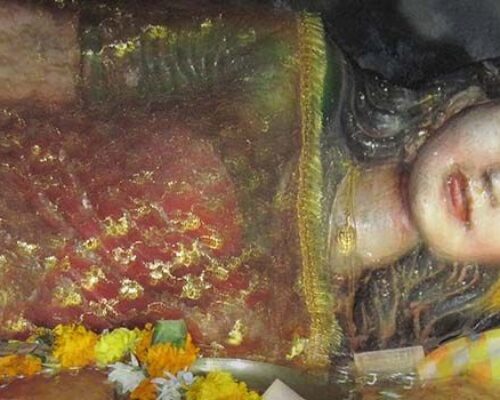The white-rumped vulture is an Old World vulture native to South and Southeast Asia. In the 1980s, the population across the globe was estimated at several million, and it was thought to be “the most abundant large bird of prey in the world”. But since 2000 the bird has been listed as Critically Endangered on the IUCN Red List, as the population severely declined. White-rumped vultures die of kidney failure caused by diclofenac poisoning. As of 2016, the global population was estimated at less than 10,000 mature individuals. You can still find some of them in Tadoba Andhari Tiger reserve while staying at Red Earth, our resort in Tadoba
The white-rumped vulture is a medium-sized vulture, with a black body, and the secondaries silver-grey, an unfeathered head and neck, very broad wings, and short tail feathers with a white neck ruff. The adult’s whitish back, rump, and underwing coverts contrast with the otherwise dark plumage. The head has a tinge of pink and the bill is silvery with dark ceres. The nostril openings are slit-like. Juveniles are largely dark and take about four or five years to acquire adult feathers. In-flight, the adults show a dark leading edge of the wing and have a white wing lining on the underside. The under tail coverts are black.

Presence In India:
The white-rumped vulture was originally very common, especially in the Gangetic plains of India, and often seen nesting on the avenue trees within large cities in the region. Many naturalists have written about the vulture as “ This is the most common vulture of India, and is found in immense numbers all over the country ” At Calcutta it was a common sight to see a seated vulture on the bloated corpse of some floating body up or down with the tide, its wing spread, to assist in steadying it.
This species, as well as the Indian vulture and slender-billed vulture, has suffered a 99% population decrease in India and nearby countries since the early 1990s. The decrease has been widely attributed to poisoning by diclofenac, which is used as a veterinary non-steroidal anti-inflammatory drug (NSAID), leaving traces in cattle carcasses which when fed on leads to kidney failure in birds. Diclofenac was also found to be lethal at low dosages to other species in the genus Gyps.
Behaviour:
White-rumped vultures usually become active when the morning sun is warming up the air so that thermals are sufficient to support their soaring. When they find a carcass, they quickly descend and feed voraciously. They perch on trees nearby and are known to sometimes descend also after dark to feed.
They swallow pieces of old, dry bones from small mammals. They bathe regularly if water is available nearby and also drink water. A pack of vultures was observed to have cleaned up a whole bullock in about 20 minutes. Trees on which they regularly roost are often white from their excreta, and this acidity often kills the trees. This made them less welcome in orchards and plantations.
The White Rumped Vulture has a special home in Tadoba. Classified as a critically endangered species, there were almost no records of the species in Tadoba in recent times until last year, when a sighting of 4 individuals was made.
If you love bird watching Tadoba and Nagarhole National Parks provide great opportunities for it. If you want to read more about the birds of Tadoba you can read our blog Birds Of Tadoba. If you want to observe them yourself, we invite you to Red Earth, our resort in Tadoba.



